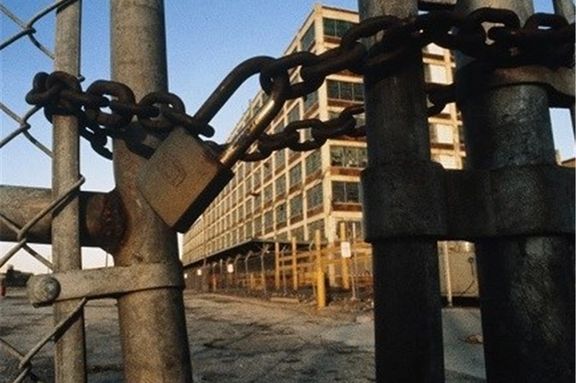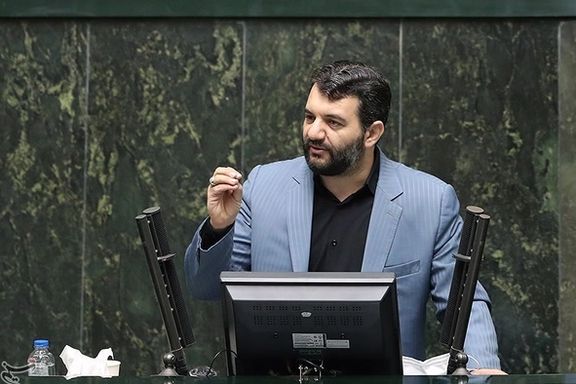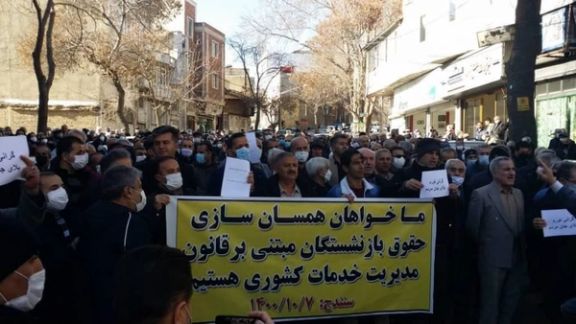Banks In Iran Have Seized 1,800 Companies For Non-Payment Of Loans

Iran’s deputy minister for industry and trade has said that bank seizures of companies and factories has increased this year, amid a deepening economic crisis.

Iran’s deputy minister for industry and trade has said that bank seizures of companies and factories has increased this year, amid a deepening economic crisis.
Mehdi Niyazi told local media that from April to September 1,793 industrial and trading companies were seized by banks after they failed to make loan payments. Most banks in Iran are fully or partly state owned.
Niyazi added that over 60 percent of companies in Iran have financial problems because of high inflation, estimated to be close to 50 percent and lack of finance.
He explained that many companies after seizure of ownership by banks stopped operations, a situation that would increase an already high unemployment rate. One bank that just last year had 60 companies under its receivership now has ownership of 160 firms.
The deputy minister partly blamed high interest rates the banks charge for the insolvency of companies struggling amid sanctions and an economic crisis.
Iran’s weak economy took a turn for worse in 2018 when the United States withdrew from the 2015 nuclear agreement and imposed tough sanctions on the country.

Dangerous levels of air pollution in Esfahan, Tabriz and more than a dozen other major Iranian cities have shut down schools and kindergartens.
According to Iran’s air quality control center, the air pollution indicator in several other cities, such as Tehran and Mashhad, has crossed the danger line for sensitive groups, but the authorities have not yet decided to close down schools in these cities.
Abed Maleki, a deputy governor for Tehran’s civil affairs coordination, said schools in the capital are not closed because the air pollution index in the city is still below 150, a level which makes it unhealthy for everyone.
However, he urged citizens, especially children and the elderly, to stay home until pollution levels decrease.
According to Ruhollah Motafker Azad, the representative of Tabriz in the parliament, the reason for the high concentration of air pollutants in Tabriz is burning mazut, a dirty fuel, instead of natural gas in its thermal power plant.
Mazut -- commonly called waste oil -- is a heavy, low quality fuel oil, only used when the facilities to blend or break it down into more conventional petro-chemicals such as diesel are not available.
Iran has the world's second largest natural gas reserves but becuae of lack of investments and technology, production is declining.

Iran’s labor minister has described unemployment as the main problem of the country, second only to inflation, but said it is not the ministry’s task to create jobs.
Hojatollah Abdolmaleki made the remarks before the Iranian parliament on Tuesday, stressing that his ministry is only responsible for coordination among other ministries and departments are tasked with dealing with unemployment.
He noted that the current administration took over the government at a time when about 14 million people did not have decent jobs, while 2.5 million people were completely unemployed.
The minister, the youngest in the cabinet, added that according to plans about 1,850,000 jobs will be created in the country in the next 18 months, an average of over 100,000 jobs per month.
According to him, about 217,000 jobs have been created during the last three months. He did not explain how so many jobs can be created amid a serious economic crisis worsened by US sanctions.
There are numerous figures about Iran’s unemployment rate, ranging from the IMF which put it at about 11 percent to other sources who report it to be over 20 percent.
Part of the huge difference in numbers might be due to the government’s definition of employment. The Islamic Republic considers anyone who works for one hour a week, as employed, which means that the government greatly overestimated the number of truly employed people.

Iranian retirees held demonstrations in the capital Tehran and several other cities to protest their low pensions that have left them at the verge of poverty.
In the Tuesday rallies, the pensioners in Tehran gathered in outside the parliament while people in other cities held their protests at the provincial offices of the Civil Servants Pension Organization.
“Stand up and fight discrimination”, read some of the banners they carried during the rallies, while they were also chanting slogans against “incompetent authorities”, asking for their resignation.
The protesters demand higher pensions on par with the country’s inflation rate and rising costs of living. The annual inflation rate has hovered around 45 percent in recent months.
They called on the country’s authorities to accelerate efforts and approve laws that can potentially improve their pensions.
A bill to address the pensioners’ demands has been languishing in the parliament for months.
Iran, which is hit hard by economic sanctions, is the scene of frequent labor protests and strikes.
Hundreds of striking and protesting workers and labor activists have been arrested since 2017, many spending months in prison. Some are still detained without trial.

Experts and media are warning Iran's government of serious consequnces if it stops allocating cheap dollars for essential imports in next year's budget.
President Ebrahim Raisi (Raeesi) recently submitted a budget bill to parliament that included eliminating the below-market exchange rate of 42,000 rial to the dollar for essential imports while increasing cash payments to citizens to compensate for any price rises.
Hamid Pourmohammadi, a senior economic policy official, told state television Monday that ending a special exchange rate for essential imports would increase inflation by just 7 percent.
Pourmohammadi, deputy head of the Planning and Budget Organization, told IRIB that higher prices for some daily purchases like bread would be compensated by increased government cash payments to citizens.But the amount of the additional payments mentioned by officials is only around $4 of cash handouts per month.
Inflation reports in recent month by the Statistical Center of Iran, a government organization has put the annual inflation rate at 45 percent.
Pourmohammadi argued that continuing to allocate dollars at a lower rate for essential imports would lead to a 28 percent jump in inflation, by forcing the government to print money to offset the fiscal losses caused by continuing high demand on foreign exchange.
The World Bank wrote last year that Covid-19 spending and “plummeting” oil revenue, due to the United States ‘maximum pressure’ sanctions that began in 2018, were taking Iran’s fiscal deficit to over 6 percent of GDP.
The subsidized rate − currently 42,000 rials to the dollar − has been in use since April 2018 - to hold down costs of imported food, medicine, and animal feed. The street rate stands at around 300,000.
There was only a single forex rate before 2018, when the government of President Hassan Rouhani introduced a subsidized rate of 42,000 after the rial fell to nearly 60,000 against the dollar in April 2018 as US president Donald Trump prepared to withdraw from the 2015 nuclear deal, the JCPOA (Joint Comprehensive Plan of Action).
Critics say forex reform, although necessary, will push up the already high rate of inflation to a level above the tolerance of vast groups of Iranians and cause a major upheaval.
"People's patience with economic [hardships] is running out,” a commentary in the conservative Asr-e Iran website Tuesday said. “The Iranian people are under 'maximum pressure’ on their subsistence. The burden imposed on them over the years has gradually grown so heavy that increasing a feather on top will break their backs."
The commentary argued there should be no price increases: "Stop…weighing people down with new economic burdens. Otherwise, the number of people who have nothing to lose will increase next year and you are better than anyone aware of the catastrophic security consequences of such circumstances."
Hassan Sadeghi a labor activist said at a union meeting on Monday said, "In fact, the government wants to offset its budget deficit by increasing the forex rate [for importing essential commodities] to the level of the rate in the open market. The pressure of this move will fall on the lower income classes and workers.”

Iranian President Ebrahim Raisi will pay an official state visit to Russia in 2022, upon an invitation by Russian President Vladimir Putin, Iran said Tuesday.
Government spokesman Ali Bahadori-Jahromi told reporters that the state visit will probably take place in the early days of the new year.
The visit was announced as representatives of Iran and Russia as well as China and three European countries are negotiating for the revival of the 2015 nuclear deal between the Islamic Republic and world powers.
Russia has been a diplomatic and military ally of the Islamic Republic, although it has been cautious not to violate economic sanctions imposed by the United States on Iran.
The two countries have been fighting in Syria to save president Bashar al-Assad's regime, with Iran supplying ground forces and Russia air power.
Successive Iranian presidents have attached great importance to ties with Moscow as a counterbalance to the West.
Earlier in December, Putin said that he invited his Iranian counterpart to visit Russia early next year, addeing, “I hope Iran’s president will accept my invitation”.